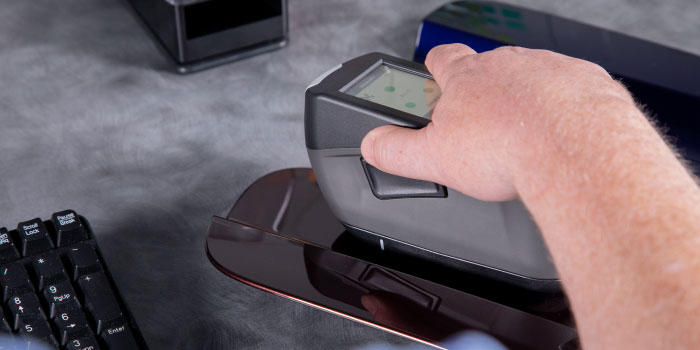Obwohl Kunststoffhersteller Farbprobleme bei der Produktion jahrelang im Griff hatten, ändern sich die Zeiten mal wieder. Immer mehr Hersteller versehen ihre Produkte – angefangen von Unterhaltungselektronik bis zu Fahrzeugteilen und flexiblen Verpackungen – mit Effektlackierungen.
Metallic-, Perlglanz- und andere komplexe Speziallackierungen mögen zwar schön aussehen und Markenartiklern dabei helfen, dass sich ihre Produkte im Verkaufsregal von Konkurrenzangeboten abheben, führen allerdings zu neuen Herausforderungen für das Farbmanagement beim Fertigungsprozess. Denn die Ausrichtung der Flakes, die Dicke des Kunststoffs und der Betrachtungswinkel tragen zum endgültigen Aussehen des Produkts bei.

Wenn Sie noch Probleme mit Effektlackierungen haben, um auf möglichst effiziente Weise ein einheitliches Farb- UND Erscheinungsbild zu erzielen, finden Sie nachstehend zwei Lösungen, damit Sie Ihrer Konkurrenz immer einen Schritt voraus sind.
1 – Charakterisierung der Aussehensmerkmale und Wirkungseigenschaften von Kunststoffen
Bei Effektlackierungen geht es nicht nur um Farbe, sondern auch um die optische Wirkung – Eigenschaften wie Textur, Glanz, Transparenz und Opazität. Zur präzisen Messung dieser Eigenschaften sind Sie auf effiziente Methoden angewiesen und müssen den gesamten Workflow vom Design bis zur Produktion ohne Qualitätseinbußen optimieren.
Das TAC™-Ökosytem (Total Appearance Capture) von X-Rite erleichtert den Prozess. Diese neue Technologie zur Messung von Wirkungseigenschaften ermöglicht die präzise Erfassung, Kommunikation und digitale Darstellung von physischen Materialien in der virtuellen Welt. Dabei hat die virtuelle Darstellung genau die gleichen optischen Eigenschaften wie das physische Material.
TAC ermöglicht ein bisher unerreichtes Maß an Realismus und Effizienz in der digitalen Materialerfassung und im 3D-Design. Mit dieser Technologie können Sie die Daten zum optischen Erscheinungsbild von Materialien in jeder Phase der Produktion austauschen – präzise und konstant. Das Ergebnis? Kürzere Design-Freigabezyklen und schnellere Markteinführung!

Und so funktioniert es.
Mit dem TAC7 Scanner können Produktdesigner, 3D-Künstler, Auftraggeber von Materialien und Werbetreibende Kunststoff-Materialproben einscannen. Der Scanner erfasst und speichert Farbe, Struktur, Glanz und andere Oberflächeneigenschaften von physischen Materialproben in einer AxF™-Datei (Appearance Exchange Format). Die AxF-Datei dient zur digitalen Kommunikation und Weiterleitung von aussehensrelevanten Daten, die dann in PLM- (Product Lifecycle Management), CAD- (Computer-Aided Design) und modernen Rendering-Anwendungen verwendet werden.
X-Rite hat AxF als anbieterneutrales Dateiformat entwickelt und freigegeben. Es ermöglicht die vollständige Kommunikation aller Daten zum Aussehen in einer einzigen bearbeitbaren Datei, die dann in Design-Tools zur Verbesserung des Virtualisierungsprozesses verwendet werden kann. Möglicherweise arbeiten Sie bereits mit Color eXchange Format (CxF), einem anderen anbieterneutralen Dateiformat, das von X-Rite entwickelt und später als ISO-Norm für die Farbkommunikation anerkannt wurde. AxF wurde als Ergänzung zum CxF-Format entwickelt, um sowohl Farbdaten als auch Daten zum Erscheinungsbild von Materialien zu speichern.
Mit seinem Ökosystem Total Appearance Capture hilft X-Rite Designern und Herstellern von Kunststoffprodukten, sämtliche Eigenschaften des Erscheinungsbilds ihrer Erzeugnisse zu erfassen. Allerdings müssen Sie auch noch etwas anderes berücksichtigen.
2 – Möglichst optimale Übereinstimmung Ihrer Geräte
Meinungsverschiedenheiten über präzise Farbgebung sind an der Tagesordnung und führen oft zu Mehrkosten durch Lieferverzug und Nacharbeit. Eine Möglichkeit zur Vermeidung dieses Problems besteht darin, einen Lieferketten-Workflow mit ausgezeichneter Geräteübereinstimmung zu implementieren. Dadurch lassen sich Abweichungen verhindern, die dadurch entstehen, dass Markenartikler, Anbieter und Hersteller mit verschiedenen Messgeräten in den verschiedenen Phasen des Prozesses arbeiten.
Folgendes Szenario treffen wir häufig an: Ein Hersteller verwendet ein Tischspektralfotometer zur Erstellung eines Referenzmusters, um dem Lieferanten seine Farberwartungen mitzuteilen. Nach der Erstellung einer Produktprobe verwendet der Lieferant ein tragbares Gerät, um sich zu vergewissern, dass sie gegenüber dem Referenzmuster innerhalb des Toleranzbereichs liegt. Die Probe besteht diese Prüfung, wird vom Hersteller jedoch abgelehnt. Was ist passiert?
SWenn der Lieferant und der Hersteller das gleiche Gerät verwendet hätten, dann hätten sie auf Basis eines Datensatzes mit optimaler Geräteübereinstimmung gearbeitet. Bei Spezialeffekten ist die Geräteübereinstimmung noch wichtiger. Denn dabei kommen Variablen zum Erscheinungsbild ins Spiel, die konstante, d. h. einheitliche Messungen noch erschweren. In unserem Blog-Artikel zur Geräteübereinstimmung finden Sie weitere Informationen zu diesem sehr wichtigen Thema.

Das MA-5 QC kann Metallic- und Perlglanz-Zusätze und komplexe Farben in Kunststoffen zur schnellen Farbkontrolle präzise quantifizieren.
Möchten Sie Spezialeffekte in Ihren Kunststoff-Workflow integrieren?
Enge Geräteübereinstimmung in Verbindung mit präziser Virtualisierung von Farbe und Erscheinungsbild sind effiziente Methoden für konstante und verlässliche Farbgebung. Wenn Sie mehr erfahren möchten, setzen Sie sich bitte mit uns in Verbindung, um einen TAC-Vorführtermin zu vereinbaren und mit uns über die für Ihren Workflow am besten geeigneten Geräte zu sprechen.

